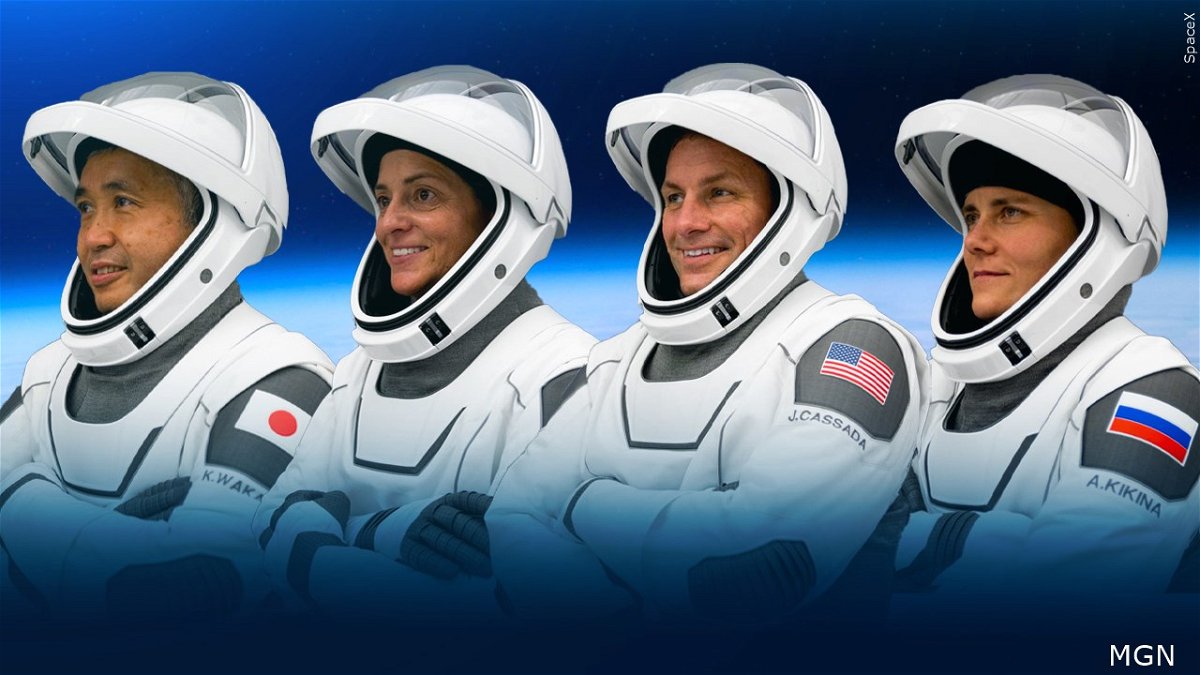Meet the history-making crew who just landed at the space station

By Ashley Strickland, CNN
(CNN) - When astronauts venture aboard the International Space Station, they see a world without borders. They work together while orbiting Earth, and no boundaries are visible between them, even as member countries contend with geopolitics on the planet below.
This week, a SpaceX Crew Dragon spacecraft with a diverse crew lifted off from Kennedy Space Center in Florida.
The capsule carried NASA astronauts Nicole Mann and Josh Cassada, astronaut Koichi Wakata of the Japan Aerospace Exploration Agency, and cosmonaut Anna Kikina of Roscosmos — the first Russian to travel on a SpaceX spaceflight.
"We live in the same world, we live in the same universe," Cassada said. "Sometimes we experience it in a very different way from our neighbors. We can all keep that in mind ... and continue to do amazing things. And do it together."
Defying gravity
The NASA SpaceX Crew-5 mission, now safely ensconced on the space station, is one of firsts.
Nicole Aunapu Mann is the first Native American woman to go to space as well as the first woman to serve as mission commander for a SpaceX mission.
Mann grew up in Northern California and is a registered member of the Wailacki tribe of the Round Valley reservation. She has been a pilot and colonel in the US Marine Corps. But it wasn't until her mid-20s that she realized she wanted to be an astronaut and that it was even possible.
"I realized that being an astronaut was not only something that was a possible dream but actually something that's quite attainable," Mann said. "I think as a young girl, I just didn't realize that that was an opportunity and a possibility."
Fossils and fireballs
A monster tsunami rippled across the planet when a dinosaur-killing asteroid crashed into Earth 66 million years ago.
The impact caused 75% of animal and plant life to go extinct and created a chain of cataclysmic events.
Waves more than a mile high pushed away from the impact crater near Mexico's Yucatan Peninsula and scoured the ocean floor thousands of miles away from the asteroid strike. The tsunami was thousands of times more energetic than those generated by earthquakes.
Sediment cores also showed that the tsunami's powerful force even disturbed coasts of New Zealand's islands halfway around the globe.
Across the universe
We get by with a little help from our friends.
The James Webb Space Telescope recently teamed up with two other space observatories to produce dazzling new images of the cosmos. By working together, these telescopes can provide a more complete portrait of the universe.
The Chandra X-ray Observatory added X-ray data to some of Webb's first images to reveal previously hidden aspects. The X-rays pinpointed exploded stars, a shock wave and superheated gas, all highlighted in glowing pinks, purples and blues.
Additionally, astronomers combined Webb and Hubble data to showcase a pair of galaxies about 700 million light-years away from Earth. Webb scientists also spied a celestial surprise, in the form of a distant galaxy, within the image.
Going green
Composting your produce scraps can be great for the environment, but there's an art to this environmentally friendly practice.
Food waste creates harmful greenhouse gases inside a landfill — and little to none of it is composted. Composting means mixing food and yard waste with nitrogen, carbon, water and air to help scraps decompose and turn into fertile soil that your garden will love.
A compost pile that stinks isn't getting enough oxygen and is emitting methane. To prevent the formation of this harmful gas, and the smell, turn your compost pile every two to five weeks.
Learn more about lifestyle changes to minimize your personal role in the climate crisis and reduce your eco-anxiety in our limited Life, But Greener newsletter series.
Trailblazers
Swedish geneticist Svante Pääbo won the Nobel Prize for medicine this week for his pioneering use of ancient DNA to answer questions about human evolution.
In 2010, Pääbo sequenced the first Neanderthal genome and discovered that Homo sapiens interbred with them. Pääbo was also able to extract DNA from fossil fragments, which revealed Denisovans, a new kind of extinct human.
His work has allowed researchers to compare human genetics with the DNA of Neanderthals and Denisovans.
Meanwhile, the Nobel Prize for chemistry was awarded to scientists who discovered how to snap molecules together, and the Nobel Prize for physics went to quantum physicists for unlocking the eerie behavior of particles.
Discoveries
Check out these new finds:
— Archaeologists have uncovered the pieces of a nearly 2,000-year-old classical statue depicting the mythical hero Hercules in northeastern Greece.
— The Pacific Ocean is shrinking and making way for a new supercontinent, called Amasia, that will likely form in about 200 million to 300 million years.
— A new image from a telescope in Chile may look like a comet, but it's actually an incredibly long debris trail created when the DART spacecraft slammed into an asteroid last month.
The-CNN-Wire
™ & © 2022 Cable News Network, Inc., a Warner Bros. Discovery Company. All rights reserved.